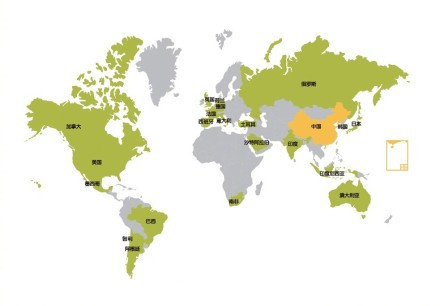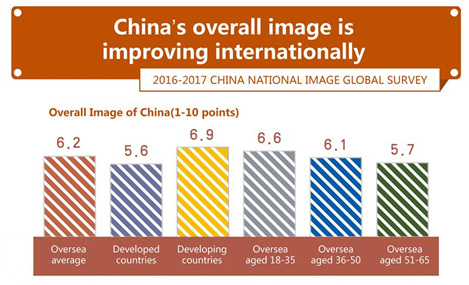
Press release of the China's National Image Global Survey 2016-2017. (Photo: Chen Yehua/ Xinhua)
According to the China’s National Image Global Survey 2016-2017 released on Friday, China’s image has steadily improved.
The global survey, conducted by the Academy for Contemporary China-World Studies, Kantar Millward Brown and Lightspeed, is based on 11,000 respondents from 22 countries, 500 citizens from each.

The survey polled on China’s overall image and influence, and its image related to politics, diplomacy, economy, culture, science and technology since 2016.
China’s overall national image has been notably enhanced under the strong leadership of the CPC Central Committee with Xi Jinping at its core since the Communist Party’s 18th National Congress, said Wang Gangyi, deputy director of the China Foreign Languages Publishing Administration.
“As socialism with Chinese characteristics has entered a new era, we are tasked with shaping China’s national image and presenting it to the rest of the world,” he said.
The platform of China’s national image survey was developed by the Academy for Contemporary China-World Studies, a national think tank for international communication, and two leading research agencies.
It is China’s first independent platform to publish regular reports based on large surveys of China’s national image on a yearly basis since 2011. The 2016-2017 China National Image Global Survey found:

1. China’s overall image steadily improving with appreciation of its performance in domestic and foreign affairs.
China scored 6.22 out of 10 for its overall image, maintaining a slight upward curve in recent years.
Generally developing countries give higher marks than developed countries, while developed countries saw a greater increase in score than developing countries.
In terms of performance in global governance, China scored 6.5 and 6.2 points in domestic affairs, showing more recognition of its ability in handling international affairs in the fields of science, technology and economy.
Overseas youth aged 18-35 had better comments on China’s performance in domestic and global affairs compared to those aged 36-50 and 51-65.
2. Respondents optimistic about China’s economy and expect China to become the world’s largest economy.
Respondents were generally positive about China’s future development. Both developed and developing country residents believed China’s international status and global influence would continue to grow and that China would lead the new round of globalization and contribute more to global governance.
More people increasingly believe that China will become the world’s largest economy: from 17 percent in 2013, 20 percent in 2014, 24 percent in 2015 and 33 percent in 2016-2017.
3. China’s Belt and Road initiative highly praised and its role in BRICS is high expected.
Overseas appreciation of the Belt and Road initiative keeps increasing year on year. More than 40 percent of respondents in Indonesia, India and other countries situated along the routes knew the initiative.
Most of the respondents thought that the initiative is significant for their countries and themselves, for regional and global economy and to global governance. Those in developing countries and youth welcomed the initiative more.
More than 60 percent of overseas respondents confirmed China’s active role in the Brazil, Russia, India, China and South Africa (BRICS) mechanism and expected Beijing to play an even more active role.
4. Quality problems hinder overseas development of Chinese brands.
Lenovo, Huawei, Alibaba, Air China and Bank of China are the five best-known Chinese brands among overseas respondents. Compared with 2015, Bank of China, BYD and other traditional brands gained in popularity.
Among overseas respondents, more than 60 percent complained about the quality of Chinese products, roughly the same as in 2015.
Young people were generally more positive toward Chinese products than older people, with fewer worries about the quality and after-sales service.
5. Chinese food, traditional Chinese medicine, high-speed railway and other cultural and high-tech elements remain hallmarks of China’s national image.
Chinese food, traditional Chinese medicine and martial arts best represent Chinese culture in the eyes of overseas respondents.
Overall nearly 80 percent of overseas respondents have eaten Chinese food. Of these, 72 percent praised its taste.
Nearly 30 percent of overseas respondents have experienced traditional Chinese medicine. Of these, 64 percent made positive comments.
About 59 percent of overseas respondents made a positive assessment of China’s technological capacity and the proportion was as high as 71 percent in developing countries.
High-speed rail, 36 percent, was China’s best known technological achievement among overseas respondents, followed by crewed space flight, 19 percent, and supercomputers, 16 percent.
6. Young people and people of developing countries strongly interested in visiting China, with a wider choice of planned destinations.
Of the overseas respondents, nearly 30 percent planned to study, work or travel in China in the next three years. The proportion was nearly 40 percent in developing countries, with the top four Indonesia, Saudi Arabia, India and Russia.
Beijing, Hong Kong and Shanghai were the three most favored Chinese cities among overseas people. This was generally the same as in 2015. Meanwhile other cities were gaining potential visitors, showing an increasing diversity in destinations.


